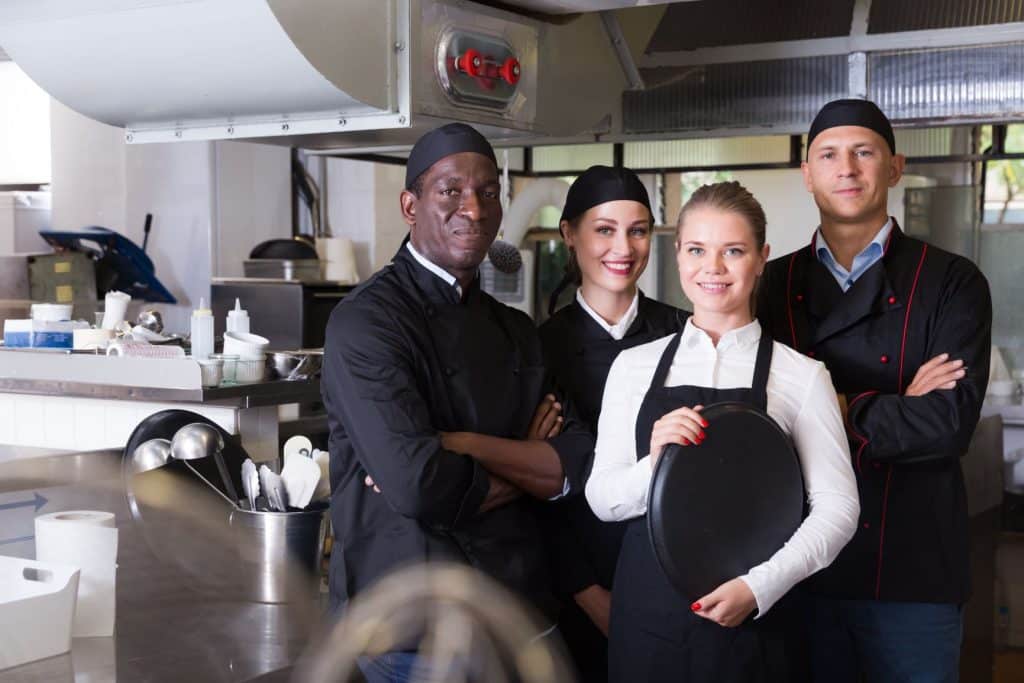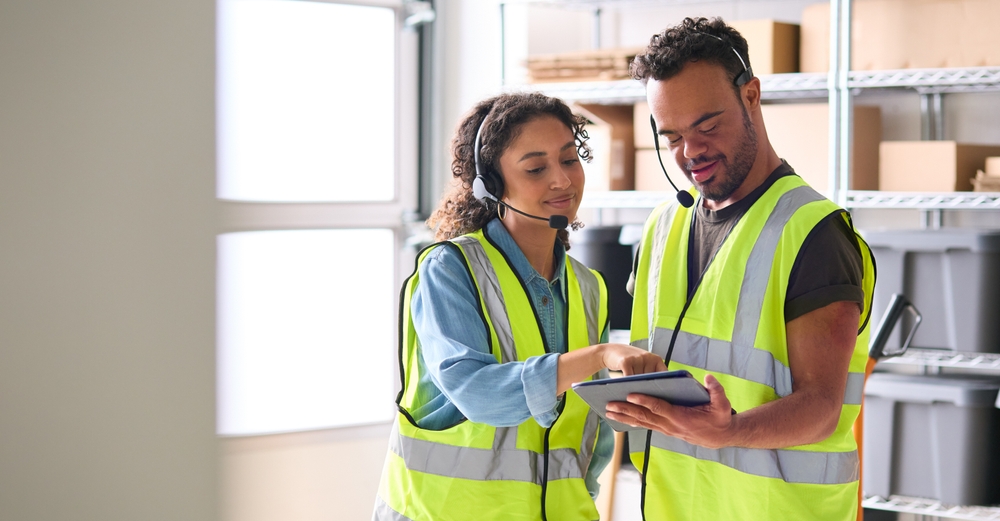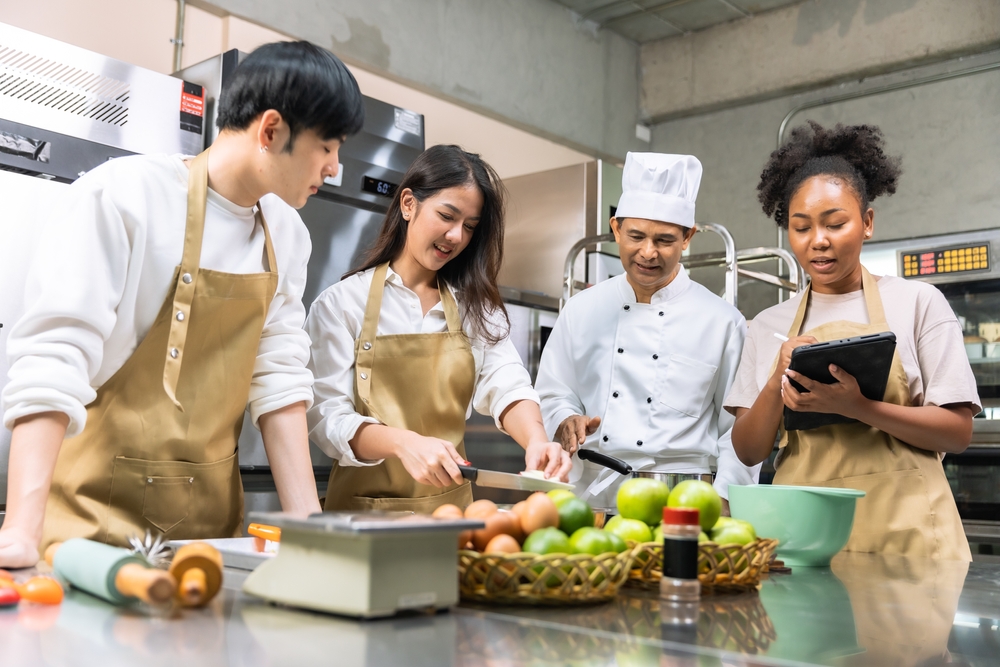A 2019 Toast report has 51% of restaurant operators saying that staffing is a top challenge, with another 35% admitting that training staff can be challenging. Devoting sufficient resources to devise an effective training method for your restaurant staff is important.
Remember that the restaurant employees are the point of contact between the company and the customers. So, there should be no compromises when equipping your waiters and restaurant staff with the tools necessary to do their job properly.
How to train your restaurant staff?
To begin with, it is recommended for a restaurant to come up with a comprehensive training program that covers all the basics. Using a set plan for all your employees will ensure consistency. List the goals and expectations of every role so that employees can tailor their work accordingly. Make sure that the individual staff members are trained for their assigned roles so they can fulfill their responsibilities efficiently.
Lacking the skills to do their duties can be frustrating for an employee because they do not feel confident about their responsibilities. For restaurant training, it is beneficial to remember that the same training methods might not be effective for every staff member. You can experiment with different audio-visual training techniques and new digital learning platforms like Bites.

How to train new restaurant employees?
New employees appreciate support and encouragement when they join the restaurant staff. Onboarding training can boost employee morale, increase productivity and encourage compliance.
Onboarding training equips them with the skills necessary to perform well in the initial weeks and orient the new staff to the restaurant and their co-workers. Keep in mind it can take some time for the new employees to acquaint themselves with the company’s culture.
Combining hands-on training with virtual lessons is one of the ways to get new restaurant employees started. A Toast report revealed that 68% of restaurants share an employee handbook for training new hires and it is accompanied by online training in 19% of the restaurants.
Restaurant service training requires a proper handbook and a formal onboarding procedure. Once you complete all the paperwork, you will be ready to welcome the new employee properly into work. Make sure to communicate all the guidelines and policies to the staff clearly to prevent misunderstandings in the future.
Important restaurant staff onboarding points:
- The staff scheduling policies should be addressed as transparently as possible.
- New restaurant employees generally receive menu training so they can recommend the best dishes to the customers.
- Give helpful and constructive feedback at every stage of the training so they know they are on the correct path.
How to train bar staff?
Restaurant employee training can also prepare a subset of your employees for handling the bar. The bar staff needs a separate training module to teach them everything they need to know about serving drinks.

1. Knowledge about drinks and their variations
All bartenders should be familiar with classic cocktails and the various twists on them. Inconsistency in the preparation of drinks can seem unprofessional for the clients. You can create a cocktail bible for your restaurant that includes the recipes of all the drinks served at the bar.
2. Daily evaluation
Having a quick refresher course with the bar staff daily is a great habit to cultivate. You can give them tidbits of information about the restaurant’s best offerings and share your secrets to a good workday. Not only will this cultivate interest in them about the drinks they are making, but they will also be more confident during their shift.
3. Staff tasting sessions
It is recommended for a fine dining service training program to accommodate frequent staff tasting sessions. The tastings develop a sense of camaraderie among the employees, and they understand how to sell the products to the guests. This investment will give you long-term value and enhance the culture of your bar.
Want to learn more? Let’s chat!
Training topics for restaurant staff
Restaurant staff training should cover a variety of topics that can help employees come up with solutions for any situation they might face.
Restaurant-specific training
This includes lessons about the menu of the restaurant and the behavior expected from the employees. New hires especially should learn the menu and common ingredients by heart so they can help guests with recommendations. Their behavior and attire should match the ambiance of the restaurant.
Promotional Training
According to a TalentLMS survey in the Food and Beverages industry, 25.5% of the respondents would like to receive more training that could help them get promotions. As a manager, caring about the progress of the staff will help you establish a relationship of trust.
Customer Service
The TalentLMS survey revealed that 70% of the respondents did not receive customer service training. That is surprising considering that the restaurant staff has to deal with customers at all times. For your restaurant to have a good reputation, you should do your best to ensure that your employees know how to treat guests.
Soft Skills
Technical skills alone cannot take your restaurant employees very far. Politeness, helpfulness and kindness are necessary soft skills for employees to develop when serving guests. Training plans should include exercises to enhance the learner’s emotional intelligence.
Compliance and Safety
The hospitality industry requires employees to have firsthand knowledge about safety protocols and hygiene measures. Compliance ensures that the staff abides by all the rules and regulations put forth by the restaurant.
Technology
With new and exciting technologies percolating into the hospitality industry, it is now more important than ever for employees to know their way around digital tools. Upgrade your restaurant with the latest gadgets and educate your employees about them properly for the best results.

Training tools used in restaurant staff training
There are a number of excellent training tools available to complement traditional instructor-led classroom training.
1. Video learning:
Videos are an effective method of training restaurant employees through realistic portrayals. Instead of relying on texts and documents, they can watch engaging videos explaining a topic.
Video learning also promotes microlearning, which means that employees are able to consume shorter modules at a time and retain the knowledge for a longer period. Videos can teach employees through demonstrations. This is recommended since most restaurant duties are practical in nature.
Bites is an innovative training tool that will allow you to communicate with your employees virtually. You can create a customized training module by creating your own videos on various subjects that you have to cover. Once you create the playlist, you can share it with your employees and have them watch the videos. You can even monitor their progress with the help of the analytics dashboard.
2. Digital learning platforms:
Digital learning platforms allow you to gather all your employees in one place virtually and impart lessons collectively. You can share learning materials and give assignments to engage everyone even when they are not together physically.
3. Restaurant employee handbook:
One of the oldest training tools in the book is a comprehensive restaurant employee handbook that can teach new employees everything about the restaurant, its history, its policies and its values. A handbook alone might not be sufficient, so you can combine it with virtual learning resources to round out your training module.
Want to learn more? Let’s chat!
Training program for employees in restaurants
A survey by TalentLMS found that 52% of the respondents received training only when they started working. Just 48% of employees received extra training beyond the onboarding training.
Restaurants should continue their staff training for as long as necessary. An ongoing training program helps to increase productivity and keeps the employees updated about policy changes. There is always something new to learn. Some of the steps of restaurant service training are:
1. Talk about the etiquette and uniform guidelines
Restaurant staff should be able to anticipate the needs of the guests and be on their best behavior. You should also outline all dress code requirements beforehand.
2. Compliance training
Clarify all the rules, regulations and policies of the restaurant to new hires. Teach them about the safety protocols and legalities of different actions. Early compliance training will help employees to not find themselves in trouble as they are starting out. Toast found that 53% of restaurants give food safety and alcohol certification training.
3. Organize an orientation
Whether you are an owner or a manager, it is recomme
nded you meet your new servers personally. This will help develop a friendly workplace culture, and they will feel comfortable approaching you. Be honest with them about the mission statement and values of the restaurant. Answer their questions and allow them to absorb the work culture.
4. Set short-term training goals
Create a fixed onboarding schedule for your employees so they
can complete their training before starting the job. The training plan can have benchmarks or small goals within itself so that the employees can have a sense of achievement at every step. Provide a customized module to each employee based on their role in the restaurant.
5. Create an online training course
In a TalentLMS survey, 38% of the respondents have engaged in online training. Try this common practice and complement your on-the-job training with virtual training resources. With today’s technology, it is easy to share content and collaborate with your employees virtually. You can quickly send over information about a new development and be assured that they will receive it. Sharing training materials with all your employees on Bites will give you the versatility you need. Bites can be linked with popular messaging apps and it allows multimedia sharing.

6. Cross-training
For a restaurant to operate smoothly, all of its components need to work together efficiently. Cross-training allows the staff to gain an insight into the work of their co-workers. New hires, especially, can benefit from cross-training because it gives them an idea of how the restaurant operates as a whole.
7. Mentorship and shadowing
Experienced servers can take new hires under their wing and help them progress. Toast found that 46% of restaurants have a mentorship program. The employees can direct their queries to their mentors and get valuable advice. Shadowing is another useful practice for any restaurant staff training plan. New servers can shadow older employees and learn about smaller technicalities and different tasks.
8. Training in the latest technologies
If you want your restaurant to appeal to younger audiences, you can embrace the latest gadgets and technologies. Digital equipment is a long-term investment that will pay off by saving time and energy. Teach employees how to use the new machines and maximize their performance. Some local governments are even enforcing the use of these digital platforms, such as tableside payment, to protect customers from the possibility of being overcharged.
Training Tools for Employees: Restaurants, Cafes, and Catering
Training tools for employees make learning effective and fun. Additionally, you can personalize your materials easily and leverage several resources to increase engagement. As a result, your learners grasp concepts quickly and retain information for a long time.
You can consider using the training tools for employees mentioned below:
Video Training Tools
66% of educators believe videos motivate students to learn. They can also engage your restaurant employees and help you teach better. You can shoot videos of, for example, preparing items on your menu and share them on your phones for more convenience.
Additionally, video learning tools like Bites let you leverage trends like microlearning to make training effective.
Computer Simulations
Simulations using technologies like augmented reality can help your employees learn new skills. Even hospitality management colleges use computer simulations to train students. They can also improve capabilities like decision-making faced with real-life situations in the simulation.
Additionally, simulations are great to teach your staff to handle kitchen equipment. They can also be ideal for safety and compliance training in amusement parks.
Online Tools Training
Online tools for training can go a long way to enhance learning. You can use a learning management system (LMS) to streamline your training and manage everything from a single interface.
Additionally, you can take advantage of mobile learning, drip-feed your content, and even conduct online tests. Entrepreneurs can choose from a range of LMS with varying features based on their needs and budgets.
Lectures
Good old lectures are perfect for sharing basic facts and fundamental knowledge. They are also suitable for explaining simple concepts. You can use lectures for onboarding or getting employees familiar with your work culture.
Additionally, you may explain your values, etiquettes, and various nuances to serve customers. However, don’t bore your employees with a two-hour-long lecture!
Benefits of restaurant staff training
Once you train servers properly, you will begin to notice the benefits. Restaurant staff training offers the following advantages:
- Employees know how to sell items on the menu to guests based on their needs. They can be empathetic while fulfilling their salesman duties.
- The staff will be trained to avoid escalation of conflicts or problems. They are aware of the rules and regulations to follow in case of trouble.
- Everyone is more productive and efficient because they know the basics by heart.
- Guests are more likely to be impressed by a restaurant with a good spirit. Trained staff knows how to create the perfect ambiance and entertain the guests. As a result, the restaurant gains more loyal customers.
- Employees will be comfortable with multi-tasking. They will have no trouble picking up the slack when the restaurant is busy.

Tips for training new employees
Training new employees effectively is the key to ensuring that they deliver great performance at work. The following tips may prove to be helpful:
- All restaurants are unique and have their traditions and methods of handling customer preferences. Holding an orientation training session will allow you to convey all relevant background information and the basics of working in your restaurants to new employees.
- Once new employees have adapted to their job duties, it is important to cross-train them so they can fit in better into the team. Learning how to perform other duties will help them collaborate with other employees and also make the restaurant much more flexible when it comes to assigning employee duties.
- Shadowing older and more experienced servers allows new employees to understand every aspect of their job better. They can see the culture of the restaurant in practice. It also promotes consistency in the way employees perform their duties.
- Emulating real-life scenarios and encouraging role-play allows employees to explore different problems and their solutions before encountering them for real. Experiencing an issue from different perspectives increases problem-solving skills.
- Ongoing training is what will set your training program on the path to success. Distributing all your information during one training session will confuse new employees, and they will be unable to retain important points. If you want your employees to be productive, knowledgeable and updated with the latest policies and industry regulations, you have to organize training sessions.
- Providing incentives to employees will increase their motivation. You can also reward them based on their performance.
Want to learn more? Let’s chat!
Restaurant training methods
You can elevate your training program by introducing effective employee training methods.
1. Peer-to-peer Training
Restaurant work is highly dependent on collaboration and mutual respect. Your employees have to develop positive relationships with the ones around them to perform well. Peer-to-peer learning encourages a mutual learning process that allows them to bond with each other. Collaborative education is also more impactful because employees feel encouraged to participate in discussions with their peers and clarify doubts and problems.
2. Mobile & Tablet Training
Mobile learning is an excellent training method for restaurant workers because of its ease and accessibility. Your employees will be able to attend training sessions between shifts and catch up on anything they have missed later on. Mobile training also ensures consistency among employees belonging to different branches of the restaurant.
3. Gamification
Gamification is the perfect way to add fun and healthy competition to your training program. Employees love the idea of learning through games because they see it as a friendly challenge. It also makes the training process more light-hearted so that employees feel more comfortable during participation. You have a lot of room to experiment with gamification now that Artificial Intelligence (AI) and Virtual Reality (VR) are more accessible.
4. Team Building
Team building exercises lead your employees to socialize even outside the restaurant, which means they have a higher chance of forming personal connections. Prioritizing team building will increase employee productivity and reduce turnover.
Checklist for restaurant training
Your restaurant service training checklist should include these effective steps:
1. Menu Tasting
Your employees will sound more sincere and organic when recommending a dish to a guest that they have already tried. Menu tasting sessions also allow the entire restaurant staff to get to know each other and interact in an informal environment.
2. Webinars
You can organize video meetings and webinars to catch up with your employees occasionally in a more informal fashion.
3. Employee Evaluation
You can test their knowledge inside the restaurant, or you can set up quizzes online for your employees. For example, Bites allows you to send quizzes and flashcards to your employees. This will encourage your employees to stay up to date on the lessons.
4. Roleplaying
Enact different situations in which employees might find themselves during work and give them a chance to show you what they have learnt.
5. Team-building exercises
Restaurant employees should work together in perfect harmony. To that end, you can arrange for team-building exercises to increase employee engagement.
If you want to create your own training module, you can sign up for the Bites free trial now!



















